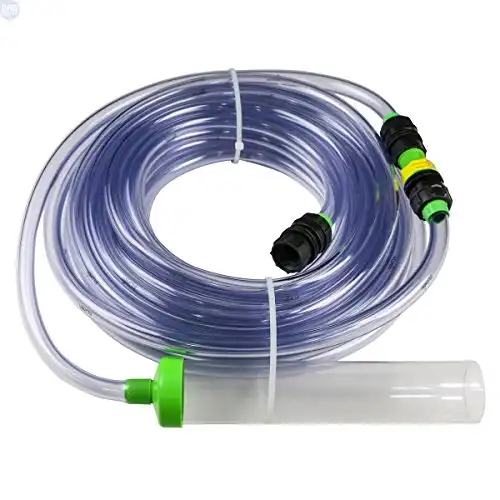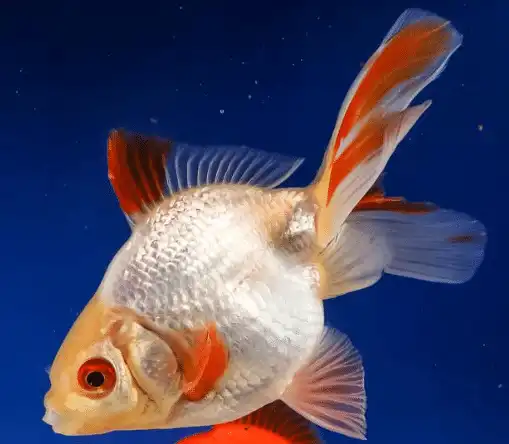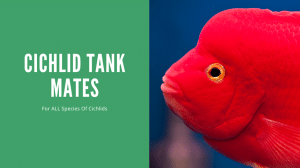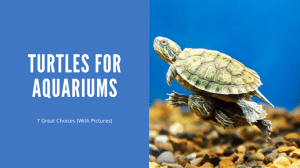Thank you for visiting! By the way… any links on this page that lead to products on Amazon and other stores/partners are affiliate links Aquarium Store Depot earns a commission if you make a purchase.
Goldfish have been bred and kept as pets for over a millennium, and today, they’re just as popular as ever! In fact, the humble goldfish is probably the most well-known and popular aquarium fish in the whole world.
Not all goldfish look the same, however. As a result of centuries of breeding, there are now many incredible types of goldfish available for your aquarium! In this article, I’ll be introducing you to the 12 best fancy goldfish types, and giving you a good introduction to their care.
So let’s get started!
What Is A Goldfish?
Goldfish are small to large freshwater fish that are kept in aquariums and ponds across the globe. These fish are members of the Cyprinidae(carp) family.
In the wild, goldfish can grow to over 15 inches and 9 pounds, although they usually stay below 8 inches in most fish tanks. Modern goldfish range from your regular common goldfish to weird and wonderful breeds like the bubble eyes and telescope goldfish.
What Makes Them Such Great Pets?
Goldfish are undemanding pets that are very relaxing to watch. It’s easy to get attached to your goldfish because each individual can have a unique appearance and personality.
Goldfish are very peaceful aquarium pets that do not show aggression towards each other or other animals in the aquarium. They can live for over a decade, although the more usual lifespan is more like 5 years.
Where It All Started
Modern-day goldfish were originally bred from a small wild goldfish species known as Carassius auratus which is native to China and other parts of Eastern Asia. Amazingly, the first records of domestication of the species go back over 1000 years!
Glass aquariums did not exist hundreds of years ago when goldfish types were being bred, so many of the characteristic features were selected to make these fish look more attractive when viewed from above.
12 Types Of Goldfish for your aquarium
Now that you know a little more about the background of one of the world’s favorite fish species, it’s time to meet some fancy goldfish types! Before we get started, here are a few important technical terms to know:
- Caudal fin: Another name for the tail fin
- Dorsal fin: The fin on top of a fish’s back
- Anal fin: The fin closest to the tail on the bottom of a fish
- Hood: A growth on the top and/or sides of the head of a fancy goldfish. Known as a wen in Chinese.
- Telescopic eyes: Protruding eyes that stick out from the sides of the head
- Metallic scales: Glossy, reflective scales
- Nacreous scales: Multicolored scales
- Matte scales: Clear scales without color
We have a video below from our YouTube channel that goes over our list. If you like our content, please subscribe. We post videos every week. We go into more detail in the blog post below.
1. Fantail
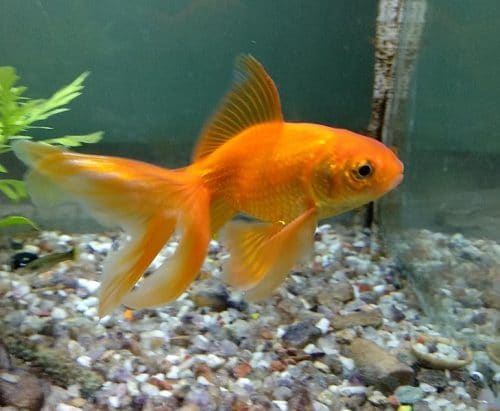
- Adult Size: 6-8 inches in length
- Color Pattern: Varied
- Unique Traits: Double tail
The fantail goldfish is one of the most popular fancy goldfish breeds. They are best known for their amazing double fins and large, flowing tail fin.
In this type of goldfish, all the fins are paired except for the dorsal fin. The body is egg-shaped and, when viewed from above, the tail creates a triangular shape.
Fantail goldfish can have either normal or telescope eyes and are available in a range of different colors and patterns.
2. Ranchu
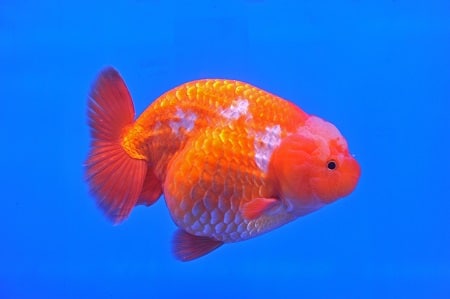
- Adult Size: 6-8 inches in length
- Color Pattern: Varied
- Unique Traits: Well developed hood, no dorsal fin
The ranchu goldfish is a Japanese breed that is seriously cute. This type of goldfish fish is best known for its prominent hood, thick body shape, and missing dorsal fin. They have a rounded back and small, rounded fins.
The impressive hood of this fancy goldfish type takes about a year to grow. Ranchu goldfish have double caudal fins that are flared out. When seen from above, this creates an interesting 3-lobed appearance.
3. Lionchu
- Adult Size: 6-10 inches in length
- Color Pattern: Varied
- Unique Traits: No dorsal fin
The lionchu goldfish is a cross between the popular lionhead and ranchu goldfish breeds. These fish share characteristics of both their parent breeds like their head growths and lack of dorsal fin.
This relatively new fancy goldfish breed was accepted in 2006 and is thought to have originated in Thailand (video source).
4. Ryukin
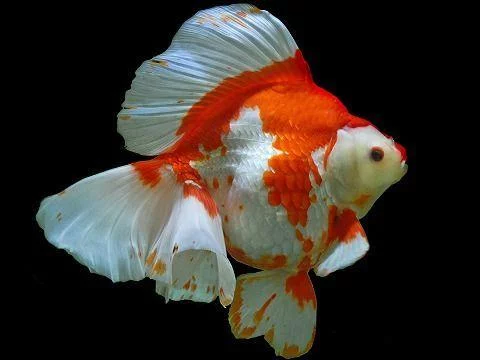
- Adult Size: 6-10 inches in length
- Color Pattern: Varied
- Unique Traits: Large shoulder hump, pointed head
The ryukin goldfish is a stunning ancient Chinese breed with a very deep body shape. The body of this fancy goldfish variety is 75% or more of the fish’s body length. The impressive humped back of the ryukin goldfish develops as it gets older.
Ryukin goldfish have a pointed head that sticks out from their massive body, creating a unique look. They have double fins that can vary in length and a large and prominent single dorsal fin.
5. Pearlscale
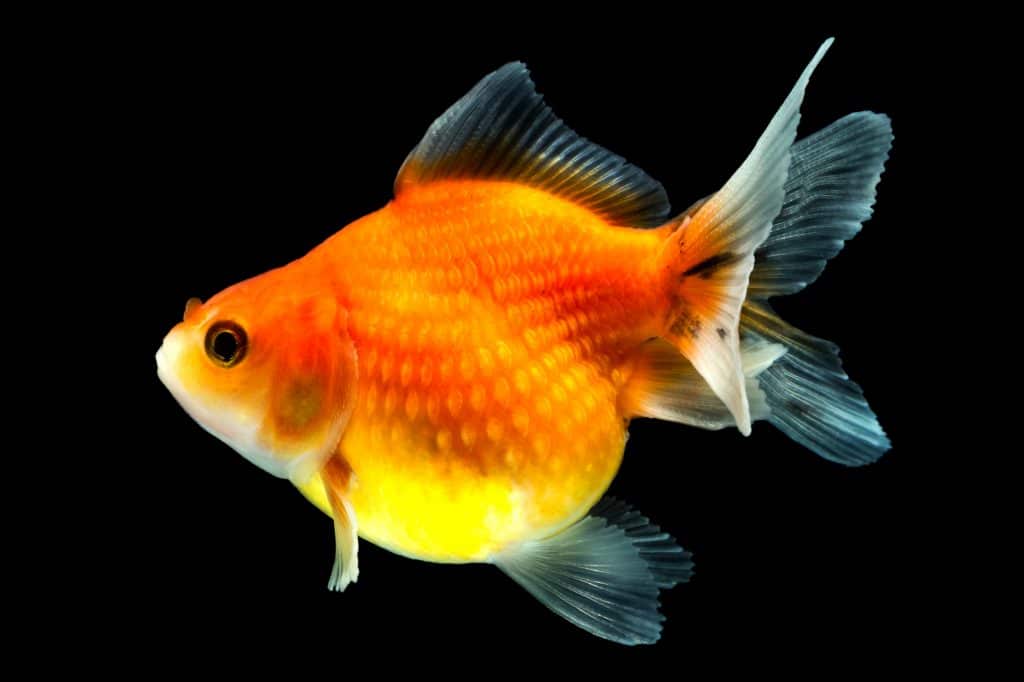
- Adult Size: 6-8 inches in length
- Color Pattern: Varied
- Unique Traits: Special scales, Spherical body
Like other goldfish from the double fin group, pearlscale goldfish have all paired fins except for the dorsal fin. The body shape of the pearlscale goldfish is short and rounded, and they can reach the size of an orange!
These fish have rounded fin tips and there are many varieties of pearlscale goldfish, including fish with oranda goldfish type heads.
6. Butterfly
- Adult Size: 6-8 inches in length
- Color Pattern: Varied
- Unique Traits: 180 degree horizontal paired caudal fins
The butterfly or butterfly tail goldfish (video source) is a breed that gets its name from its double tail fins. These fins are spread out and flattened. The effect is that the caudal fins look like a flying butterfly when viewed from above.
This amazing feature isn’t all that’s interesting about this breed though. These fancy goldfish belong to the double-finned group of breeds and butterfly goldfish most often have telescopic eyes/dragon eyes. This breed of goldfish is also available with normal eyes, however.
7. Oranda
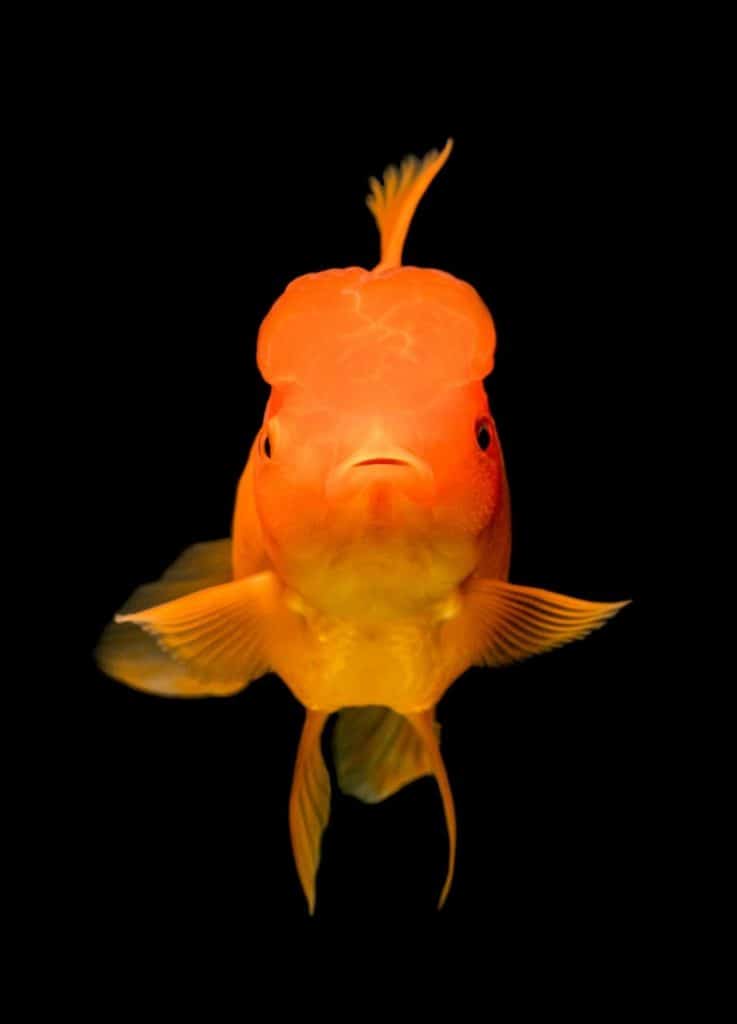
- Adult Size: 8-12 inches in length
- Color Pattern: Variable
- Unique Traits: Large hood, egg-shaped body
Oranda goldfish are a spectacular breed. They have an egg-shaped body with a prominent hood/wen. These fish have well-developed, flowing fins, including a large dorsal fin.
They have a similar body shape to the fantail goldfish. There are many different forms of oranda goldfish, with different color hoods and even telescopic eyes.
8. Black Moor
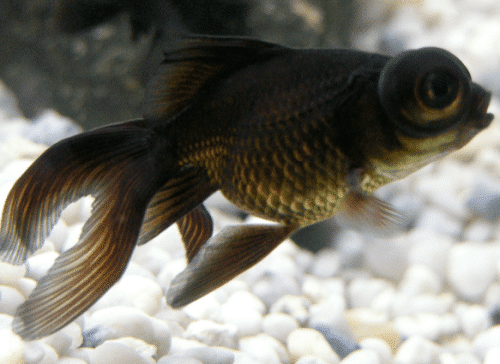
- Adult Size: 6-8 inches in length
- Color Pattern: Black
- Unique Traits: All-black color and telescopic eyes
The black moor is a popular and dramatic-looking telescope eye goldfish breed. These all-black fancy goldfish are one of the most easily recognizable breeds.
The black moor goldfish has a rounded body and the same double finnage as the typical fantail goldfish.
9. Veiltail
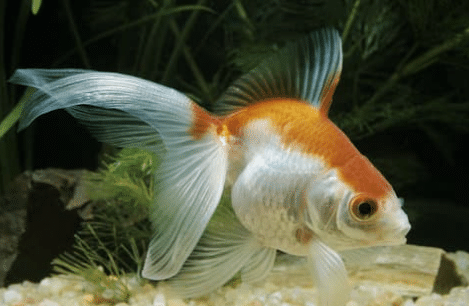
- Adult Size: 6-8 inches in length
- Color Pattern: Varied
- Unique Traits: Large double tail with a straight edge and no fork, sail-like dorsal fin
The veiltail goldfish is a rare breed that is known for its large and beautiful tail. In this type of goldfish, the caudal fin should be 1 to 1.5 times the length of the body. Furthermore, the lobes of the caudal fin are not forked, and the back edge of the fin should be straight.
It is not only the tail that is impressive, this breed also has a large, upright dorsal fin. Veiltail goldfish have a similar body shape to the fantail goldfish, with the same double fins. Veiltail goldfish can have matte, nacreous, or metallic scales.
10. Lionhead

- Adult Size: 6 inches in length
- Color Pattern: Varied
- Unique Traits: Large hood, no dorsal fin
The Lionhead goldfish is a centuries-old Chinese breed of fancy goldfish. They have a very well-developed hood that covers almost their entire head.
This breed was created before the ranchu and has a similar egg-shaped body. While they also have paired caudal and anal fins, and no dorsal fin, these slow-moving fish differ from the ranchu by having a fairly straight back.
11. Bubble Eye

- Adult Size: 3-5 inches in length
- Color Pattern: Varied
- Unique Traits: Large sacs(bubbles) below the eyes, no dorsal fin
The bubble eye is one of the strangest fancy goldfish breeds available. These fish have fluid-filled sacs on their cheeks that make their eyes bulge out and look upwards.
Apart from their protruding eyes, bubble eye goldfish have the same body shape as the ranchu goldfish and also lack a dorsal fin. Because of this extreme body modification, bubble eye goldfish are pretty weak swimmers and need special care and tank setups to avoid injuries.
12. Sabao
- Adult Size: 6-8 inches in length
- Color Pattern: Red and White
- Unique Traits: Strongly forked single tail
This uncommon Japanese breed is also known as the Tamasaba goldfish (video source). They are a single tailed goldfish breed with a strongly forked caudal fin with pointed tail fins, almost like a fast swimming ocean fish.
While this fancy goldfish variety does have a plump body, the shape is more like a common or comet goldfish than some of the round-bodied breeds. These beautiful fish usually have red and white body colors.
Colors
You may have noticed that almost all of the fancy goldfish types in my list are available in varied colors. Let’s take a look at some of the most common goldfish colors:
- Red
- Orange
- Yellow
- White
Other Colors
apart from the regular colors you expect to see on a goldfish, there are also some more subtle and natural color forms available. These include:
- Green- Green goldfish are actually more of a light bronze color than a true green
- Black – Black goldfish are relatively rare. The black moor goldfish is a great example of this color morph
- Blue – Blue goldfish have a dusty black look, rather than a true blue color
- Wild/Iron – The silvery brown color of wild goldfish
- Uncolored – Uncolored goldfish have the wild/iron color when young. They often develop brighter adult colors as they mature
Patterns
Goldfish come in an almost infinite variety of patterns, and that’s what makes each individual so unique! Apart from single-colored fish, there are some well-recognized goldfish patterns that you are likely to encounter out there like:
Panda
These goldfish are also known as magpie or black and white goldfish. They are variously marked in pure black and white.
Calico/Multicolored
Calico goldfish usually have nacreous scales. They can have multiple different colors, in complex patterns.
Redcap
These goldfish typically have a white body with a red ‘cap’ on the head.
Whitecap
These goldfish typically have a red body with a white ‘cap’ on the head.
Scale Types
The type of scales is another characteristic that varies between different individual goldfish. Fancy goldfish can have 3 different types of scales. These are:
Metallic
This is the most common scale type. Metallic scale types are glossy and reflect a lot of light. These scales are typically single-colored.
Matte
This scale type is translucent and does not reflect any light. Goldfish with matte scales do not have typical colors and tend to be a pinkish color.
Nacreous
This scale type is a mix between metallic and matte. Goldfish with nacreous scales can be multicolored, like calico goldfish.
Tank Setup
Successful goldfish keeping starts with the right fish tank setup for their needs. In this section, we’ll take a closer look at how to set up a great goldfish aquarium.
Tank Size
Although many pet stores sell goldfish bowls, the truth is that goldfish need plenty of space. As a general rule, an aquarium of 20 gallons is necessary for keeping a single goldfish, and you’ll need a further 20 gallons for each additional goldfish you add.
That might sound like a lot of space for a 6-inch fish, but remember that goldfish are very stocky, which makes them very large in relation to their body length. Since they prefer to live in groups, you’ll need a fairly large aquarium to set up the perfect home for your fish.
Substrate
A substrate is not absolutely necessary for your tank. A bare bottom aquarium makes cleaning much easier but does not provide a very natural look.
https://aquariumstoredepot.com/blogs/news/what-do-goldfish-eatGoldfish love to search the substrate at the bottom of the tank while looking for food, and this natural behavior is not possible in a bare bottom tank. To create a more natural environment for your fish, consider using a fine gravel or sand substrate.
This sand by Caribsea is perfect for supporting the foraging habit of goldfish. Also works with bottom feeders and discus fish.
Filtration
An aquarium filter is a very important piece of hardware for your goldfish tank. You can use just about any kind of filter for common goldfish, but weaker swimmers like bubble eye goldfish will do far better with a simple sponge filter that creates a very gentle flow.
Goldfish produce plenty of waste, so adequate filtration is important. That means you can run several sponge filters or even a combination of a hang-on back or canister filter with additional sponge filters.
Goldfish like cool, well-oxygenated water. Sponge filters are useful for oxygenating the water, but running a simple airstone or bubbler as well is a good idea.
Heating
Goldfish are cool water fish, which means they do not require a heater in many homes. Their ideal temperature range lies between 65-72°F, so if your home gets below these temperatures, a heater will be necessary.
At the same time, if you live in a tropical climate and the water in your aquarium naturally rises above about 72°F, you would need to keep your tank in an air-conditioned room or run an aquarium chiller to keep your fish comfortable.
Other Important Parameters
- pH: 7-8
- GH: 150ppm
- KH: 70-140ppm
Live Plants for Tanks
Goldfish are omnivorous, and they love to feed on live plants. Unfortunately, this means they are not good fish for aquascaped aquariums. There are, however, a few species of plants that goldfish don’t usually feed on.
Here are a few popular choices:
Your other option is to grow fast-growing plants that can keep up with your goldfish’s appetite and provide them with a natural food source. The following species work great for this:
- Duckweed
- Water Sprite
Fake plants are another option if you would like to green up your tank without growing live plants. Be sure to select plant decorations that are aquarium safe, and have soft, smooth surfaces that can’t damage your goldfish’s eyes or fins.
Silk plants that are designed to be gentle on fish with fancy fins like Bettas and Fancy Goldfish
Decorations
Although decorations aren’t strictly necessary, they are a great way to make your aquarium more aesthetically pleasing.
You can let your creativity run wild when choosing your decor, but remember to keep the health of your fish in mind.
Fancy goldfish can be pretty clumsy, and sharp decorations can be a serious hazard for them. Veiltail goldfish, for example, have long flowing fins that can easily tear. Bubble eye goldfish can also burst the fluid-filled sacs on their cheeks on sharp objects.
Care Instructions
Goldfish are a relatively easy species to care for once you understand their needs. They are social creatures that should be kept in a pair at a minimum. Let’s take a look at how to keep your fancy goldfish well taken care of.
Water Quality
Maintaining good water quality is the key to success for any tank, and a goldfish aquarium is no different. Poor water quality puts your fish under stress, and this can lead to poor health and disease.
Good water quality is a result of an appropriate size tank, good filtration, correct feeding, and regular maintenance.
Testing
In order to keep your goldfish happy and healthy, you will need to keep your water parameters stable at the values listed above. To do this, you’ll need a test kit so that you can measure and monitor your water chemistry.
A liquid test kit is all that you will need. Choose a test kit that allows you to measure all of the following parameters:
- Ammonia
- Nitrite
- Nitrate
- pH
An inexpensive aquarium thermometer is also useful for monitoring the water temperature in your aquarium.
Aquarium Maintenance
Goldfish are hardy fish, but they do need good water quality and regular maintenance and monitoring. This means you’ll need to roll up your sleeves and get your hands wet every now and then to keep your pet’s tank in great shape.
Water changes and gravel vacuuming are the two most important maintenance activities, and you will need to do this every week or two. The bigger your tank, and the fewer fish you keep, the longer you can go between water changes.
Remember to test your nitrate levels regularly, because this will help you work out the perfect maintenance schedule for your tank. Ideally, you should aim to keep your nitrates to 20ppm, but goldfish are hardy fish, so anything below 50ppm before a water change is still well below their tolerance level.
Use your gravel vacuum or python system to suck up any waste at the bottom of your tank while removing water, and take this time to scrape off any algae that is growing on the glass of your aquarium.
The Python is a mainstay in the fish hobby. Easily clean your aquarium by connecting this to your sink!
The new water you put into the tank should be the same temperature as the water you took out, and always remember to use a water conditioner to neutralize harmful chemicals like chloramine in tap water.
Feeding Instructions
Goldfish are omnivorous, which means they eat both plant and animal foods. High protein diets can be good for improved growth and color, but balance is very important. To keep your goldfish in great health, always feed them a high-quality, varied diet.
The following food sources are recommended:
- High-quality sinking pellets
- Frozen brine shrimp
- Frozen bloodworms
- Vegetables
Many keepers feed floating foods without any issues, but there are reports of fish ingesting too much air while feeding at the surface. If your fish develops buoyancy issues, a change of diet may be necessary.
In warmer water, you can feed your goldfish 2 or 3 times a day. In cooler water, your fish will be less active and can be fed once a day or so. Avoid overfeeding your pets by only supplying enough food for them to finish within about 2 minutes.
For some clumsy fancy goldfish, 2 minutes may not be enough time for them to finish a meal. Another rough estimate then is to feed your fish a portion size that is the same size as one of their eyes.
Tankmates
It is best to keep goldfish in a species-only tank. Furthermore, slow-moving fancy goldfish types should only be kept with other goldfish with similar needs, rather than with faster moving single tail common goldfish. This is to give the fancy goldfish a fair chance at reaching the food at mealtimes.
There are some other fish that are compatible with goldfish. Goldfish community tanks are only a good idea for more experienced goldfish keepers though. The important thing is that any tank mate must be peaceful and enjoy the same cooler water temperatures.
Possible options include:
- Mystery snail
- Hillstream loach
- Dojo loach
- Rosy barb
- White cloud minnow
Breeding
Although it can be challenging, it is possible to breed your goldfish at home. For starters, you will need an adult pair. Unfortunately, the goldfish sexes are not that easy to tell apart.
You can identify a male goldfish by his smaller, more streamlined body. You may also notice spots on his pectoral fins, and small bumps (tubercles) that develop on his gill covers when ready to breed.
Female goldfish tend to be heavier, with deeper bodies. The vent of a female goldfish will also protrude slightly when she is in breeding condition.
Goldfish prefer to breed in the spring, and if you find one of your goldfish is constantly following another one, you could have a breeding pair. When ready, they will spawn on plants in the aquarium and this is where the eggs will stick.
You will need to move the plant with eggs to a separate tank or container. Run an airstone in this tank to keep the eggs well oxygenated. The fertilized eggs will hatch in just days.
If successful, you will have a huge number of fry to feed with baby brine shrimp. Congratulations!
Health Problems
Goldfish are generally hardy, but they can be susceptible to a few common goldfish conditions such as:
- Swim bladder disease and other buoyancy issues
- Polycystic kidney disease
- Parasites such as anchor worms and fish lice
- Bacterial infections such as fin rot
- Fungal infections
The best way to prevent health problems is to keep your fancy goldfish in excellent water quality, feed them a high-quality diet, and keep their water at the correct temperature.
Due to the heavily modified body shapes of some of the fancy goldfish breeds, they can be affected by a few specific problems. Eye and fin injuries can be avoided by keeping sharp objects out of the tank.
Bubble eye goldfish can be very susceptible to infections if their bubbles should become damaged. Fortunately, their bubbles can heal and restore themselves naturally under ideal circumstances.
You can prevent exhaustion in weaker swimmers like ranchu goldfish by running sponge filters, rather than power filters.
Where To Buy
Goldfish are one of the easier types of fish to find at your local pet store. Most aquarium stores sell common goldfish as feeder goldfish for other carnivorous aquarium fish. For different types of goldfish and fancy breeds, buying online or getting in touch with a local club is another great option.
Fancy goldfish come in a variety of types and make great aquatic pets. Check out these What You See Is What You Get (WYSIWYG) goldfish in the link below!
FAQS
How many types are there?
There are about 200 types of goldfish breeds recognized today. Many of these fancy goldfish breeds are ancient, although breeders continue to create new fish today.
What type can live together?
Goldfish are peaceful animals that do not fight with each other. The only consideration when putting different breeds together is their speed and ability to compete for food.
It is best to not keep fast-moving breeds like comet goldfish with slower breeds like the lionhead goldfish.
Which is the hardiest?
The hardiest fancy goldfish are probably the breeds that are most similar to the regular common goldfish. Single-tailed types of goldfish like the comet goldfish are a good example.
What is the difference between a regular and a fancy breed?
Fancy goldfish are special breeds that have been bred for various traits like body and fin shape, double fins, head growths, and bubble eyes. A regular common goldfish can still be a beautiful fish but is not considered a fancy goldfish.
Which is the most popular?
The classic fantail is probably the most popular of the fancy goldfish varieties.
Final Thoughts
The fancy goldfish varieties make some of the best pets in the aquarium world because they are just so adorable and full of personality. I love that there are so many different types of goldfish and the rich history behind these fish is fascinating.
Which is your favorite goldfish breed? Let me know below!
- About the Author
- Latest Posts
I’m thrilled that you found Aquarium Store Depot! Here you’ll find information on fish, aquariums, and all things aquatics related. I’m a hobbyist (being doing this since I was 11) and here to help other hobbyists thrive with their aquariums! I adhere to a high quality Editorial Process and Review products with real life field usage and practical analysis.




